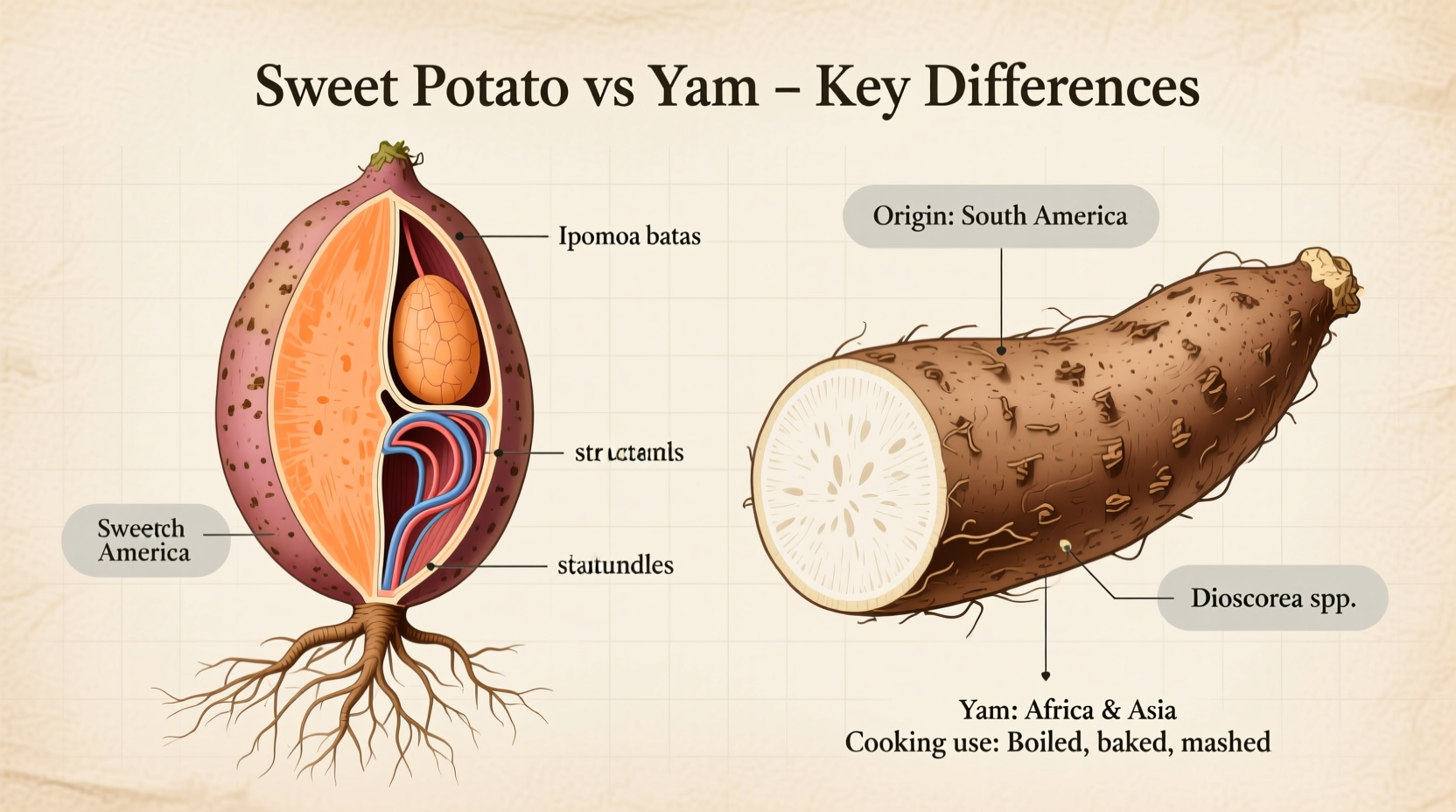Confused about sweet potatoes versus yams? You're not alone. Most Americans have been calling orange-fleshed sweet potatoes “yams” for decades, creating widespread misunderstanding about these two distinct root vegetables. This comprehensive guide cuts through the confusion with scientifically verified differences you can trust.
The Great American Labeling Mix-Up
When you see “yams” in US grocery stores, you're almost certainly looking at sweet potatoes. This mislabeling began in the 1930s when orange-fleshed sweet potatoes were introduced to distinguish them from traditional white-fleshed varieties. Southern producers adopted the African word “yam” (pronounced “yahm”) as a marketing tactic, and the confusing terminology stuck. The USDA now requires packages labeled “yams” to also include “sweet potato” to prevent consumer deception.
Botanical Origins and Classification
Sweet potatoes (Ipomoea batatas) are members of the Convolvulaceae (morning glory) family and originated in Central and South America over 5,000 years ago. True yams belong to the Dioscorea genus in the Dioscoreaceae family, with most varieties originating in Africa and Asia. These plants aren't even distant cousins – they're as unrelated as apples are to oranges.
| Characteristic | Sweet Potato | True Yam |
|---|---|---|
| Scientific Family | Convolvulaceae (morning glory) | Dioscoreaceae |
| Origin | Central/South America | Africa/Asia |
| Texture | Moist, tender when cooked | Dry, starchy, potato-like |
| Skin Texture | Thin, smooth, easily scratched | Rough, scaly, bark-like |
| Shelf Life | 3-5 weeks | 6+ months |
Physical Characteristics Compared
Sweet potatoes typically have tapered ends with thin, smooth skin ranging from pale yellow to deep copper. Their flesh varies from white to orange to purple. True yams feature rough, almost bark-like skin with dark brown or black coloration. They grow much larger than sweet potatoes – some varieties reach over 100 pounds! Yams have white, less moist flesh that resembles a regular potato more than a sweet potato.

Nutritional Profile Differences
While both provide valuable nutrients, their nutritional compositions differ significantly. Sweet potatoes, especially the orange varieties, are famous for their exceptionally high vitamin A content (as beta-carotene). One medium sweet potato provides over 400% of your daily vitamin A needs. Yams contain more potassium and manganese but significantly less vitamin A.
| Nutrient (per 100g) | Sweet Potato | True Yam |
|---|---|---|
| Calories | 86 | 118 |
| Vitamin A | 14,187 IU (284% DV) | 2 IU |
| Vitamin C | 2.4 mg | 17.1 mg |
| Potassium | 337 mg | 816 mg |
| Dietary Fiber | 3 g | 4.1 g |
Where to Find True Yams
True yams are uncommon in standard American supermarkets but can be found in international markets specializing in African, Caribbean, or Asian foods. Look for names like “nyami,” “ignames,” or “Chinese yam.” In contrast, sweet potatoes are widely available across North America and Europe. This availability difference explains why the mislabeling persists – most consumers outside tropical regions have never encountered a true yam.
Culinary Applications: When to Use Which
Sweet potatoes work beautifully in both sweet and savory dishes due to their natural sugars. They're perfect for roasting, mashing, or using in pies and desserts. True yams, with their starchier composition, function more like regular potatoes and excel in soups, stews, and fried preparations common in West African and Caribbean cuisines. Never substitute one for the other in recipes calling for specific textures – the results will disappoint.
Shopping Guide: Identifying What You're Buying
When shopping in North America or Europe, assume any “yam” is actually a sweet potato. Look for these identifiers:
- Copper-skinned, orange-fleshed varieties: These are “soft” sweet potatoes (often mislabeled as yams)
- Tan or light brown skin, pale flesh: These are “hard” sweet potatoes
- Rough, bark-like skin, very large size: These are likely true yams (found only in specialty markets)
Historical Context of the Confusion
The sweet potato/yam misnomer has deep historical roots. When enslaved Africans were brought to America, they encountered sweet potatoes that reminded them of the true yams from their homelands. They began calling sweet potatoes “yams” as a cultural reference. Commercial producers later adopted this terminology to distinguish orange-fleshed varieties from traditional white-fleshed sweet potatoes. According to agricultural historians at the University of Florida (UF/IFAS Extension), this marketing decision in the 1930s cemented the confusion that persists today.
Global Perspective on Terminology
Outside North America, the distinction is clearer. In the UK, “sweet potato” is the standard term, while “yam” refers exclusively to true yams. In West Africa, where yams are a cultural staple, the word “yam” never refers to sweet potatoes. The International Potato Center (CIP) emphasizes that maintaining accurate terminology supports agricultural research and food security initiatives in yam-producing regions.











 浙公网安备
33010002000092号
浙公网安备
33010002000092号 浙B2-20120091-4
浙B2-20120091-4